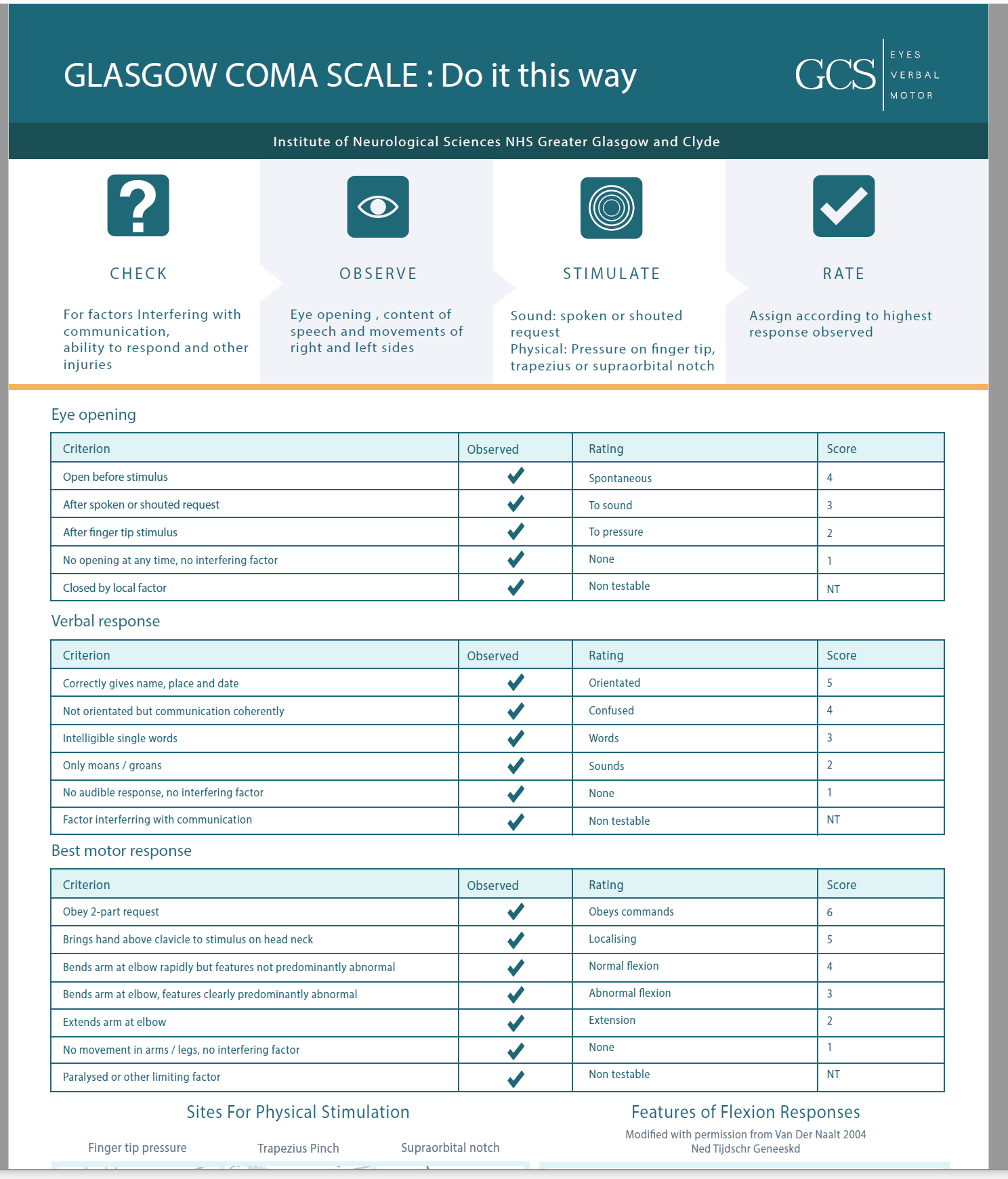Makindo Medical Notes"One small step for man, one large step for Makindo" |
|
|---|---|
| Download all this content in the Apps now Android App and Apple iPhone/Pad App | |
| MEDICAL DISCLAIMER: The contents are under continuing development and improvements and despite all efforts may contain errors of omission or fact. This is not to be used for the assessment, diagnosis, or management of patients. It should not be regarded as medical advice by healthcare workers or laypeople. It is for educational purposes only. Please adhere to your local protocols. Use the BNF for drug information. If you are unwell please seek urgent healthcare advice. If you do not accept this then please do not use the website. Makindo Ltd. |
Glasgow Coma scale
-
| About | Anaesthetics and Critical Care | Anatomy | Biochemistry | Cardiology | Clinical Cases | CompSci | Crib | Dermatology | Differentials | Drugs | ENT | Electrocardiogram | Embryology | Emergency Medicine | Endocrinology | Ethics | Foundation Doctors | Gastroenterology | General Information | General Practice | Genetics | Geriatric Medicine | Guidelines | Haematology | Hepatology | Immunology | Infectious Diseases | Infographic | Investigations | Lists | Microbiology | Miscellaneous | Nephrology | Neuroanatomy | Neurology | Nutrition | OSCE | Obstetrics Gynaecology | Oncology | Ophthalmology | Oral Medicine and Dentistry | Paediatrics | Palliative | Pathology | Pharmacology | Physiology | Procedures | Psychiatry | Radiology | Respiratory | Resuscitation | Rheumatology | Statistics and Research | Stroke | Surgery | Toxicology | Trauma and Orthopaedics | Twitter | Urology
Related Subjects: |Assessing Coma and Management |Glasgow Coma scale |Acute Poisoning |Trauma: Traumatic Brain Head Injury (TBI)
🧠 The Glasgow Coma Scale (GCS) is a vital score for assessing consciousness. 🚨 Remember: *changes* in GCS are often more important than the absolute number. 💡 Always describe what the patient can/can’t do rather than quoting just numbers. ⚠️ A dysphasic patient may score "1" on verbal response, but you should clarify "V1 (dysphasic)" rather than implying complete unresponsiveness. 🔒 Patients with GCS ≤ 8 are generally intubated to protect the airway and prevent aspiration pneumonitis. 👩⚕️ If GCS is reduced ➝ escalate to senior support immediately.
📖 Introduction
- The GCS is used to assess consciousness in head injury 💥, coma, and other acute brain disorders.
- It evaluates 3 domains: 👀 Eye-opening, 🗣️ Verbal response, ✋ Motor response.
- Total scores range from 3 (deep coma) ➝ 15 (fully alert).
📊 Scoring Overview
- Total GCS = E + V + M
- Severe: 3–8 ❌
- Moderate: 9–12 ⚠️
- Mild: 13–15 ✅
🔍 How to Perform
- 👀 Eye response ➝ spontaneous? to voice? to pain?
- 🗣️ Verbal ➝ oriented? confused? incomprehensible?
- ✋ Motor ➝ obeys? localises? flexion/extension?
Note: If intubated, tracheostomised, or aphasic ➝ record as V-NT (not testable).
📋 GCS Table
| Category | Response | Score |
|---|---|---|
| 👀 Eye Opening (E) | Spontaneous | 4 |
| To Speech | 3 | |
| To Pain | 2 | |
| None | 1 | |
| 🗣️ Verbal Response (V) | Oriented | 5 |
| Confused | 4 | |
| Inappropriate Words | 3 | |
| Incomprehensible Sounds | 2 | |
| None | 1 | |
| ✋ Motor Response (M) | Obeys Commands | 6 |
| Localises Pain | 5 | |
| Normal Flexion (Withdraws) | 4 | |
| Abnormal Flexion (Decorticate) | 3 | |
| Extension (Decerebrate) | 2 | |
| None | 1 |
📌 Interpretation
- 13–15: Mild head injury 😊
- 9–12: Moderate injury ⚠️
- 3–8: Severe coma ❌ ➝ airway protection needed
🏥 Usage
Used in ED, ITU, and neurology/stroke wards to assess consciousness. Helps guide airway management, neurosurgical referral, and prognosis in traumatic brain injury and other comatose states. Always compare with previous scores to identify deterioration. 📉
🖼️ Visual Aids

